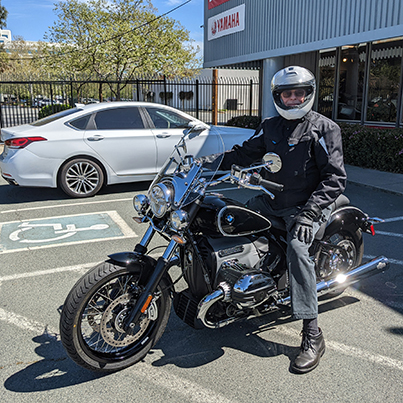
|
All things must come to an end, and it would seem that my history and my experiences as a motorcycle rider are among them.
I started riding almost fifty years ago, in 1973. I had been interested in motorcycles ever since some of the cooler boys in my high school class were batting around town on them—well, on 150 cc Hondas, barely better than a scooter, but the vibe was there. I myself had no occasion to ride all through high school and college, but after graduation and with some money of my own for the first time, I decided to try it. And my brother, who was older and had gone into the Air Force, rode motorcycles when he was stationed in Taiwan—again small machines, a Honda Dream and a Yamaha dirt bike—and anything he could do was something I wanted to try.
Because my brother was also enthusiastic for BMWs, I wanted to buy a BMW motorcycle first thing. But my father, who was wiser, suggested that $2,200—the price of an R75/5 at the time—was a lot to pay for something I might not like. So I bought a smaller machine, a Yamaha RD350, which really was considered a “hot bike” but with a frame and seat position too small for my six-foot-six body. But I learned to ride—which meant, in those days, that the dealer let me trundle it around the parking lot a couple of times before I headed off for home and evermore.
I dropped that bike twice. The first time was my first rainy day, first wet manhole cover, and first experience of the rear wheel—which I was precariously overbalancing—going out sideways underneath me. I ripped up a pair of pants, bruised my backside, and did a couple of hundred dollars in damage as the machine slid down the street on its side. The second time was when I stopped on a hill, about to make a sharp left turn across traffic, cocked the handlebar into full steering lock, and tipped the bike over, pivoting on that front axle. No injuries but more damages to repair.
After a year, and despite these mishaps—including a blown cylinder, because I did not realize that a tiny, two-stroke engine with aluminum pistons drives differently from a car—I was in love with motorcycling. I bought that R75/7 and rode it for three years, until I got married and needed to sell it for a down payment on our first home together.
I stayed away from motorcycles for about five years that time, but then the bug bit again. I bought a BMW R100, the same basic machine as my previous bike but with a 1,000 cc engine. I customized that BMW with saddle bags, an oil cooler, fork brace, and windshield, and rode it as a commute bike into San Francisco on sunny days. These were both opposed twin-cylinder, or “boxer,” engines. Four years later, when BMW brought out the first of its in-line four-cylinder motorcycles, designated with the letter K, I traded up. Over the years, I have bought twenty of the BMW machines, about half of them boxer Rs and half in-line Ks. And I loved each one as if it would be my one and only, forever, last motorcycle. But sometimes I have owned two bikes at once, just for the variety of having different machines with different riding styles.1
Along the way, I have also owned two Harley-Davidsons. They are a different style of riding, with all of the motorcycle’s weight comfortably underneath you. They are good motorcycles, but they lack the precision, the fit and finish, and the power of the BMWs.
Sometimes I have gone off motorcycling for a couple of years. Then I have kidded myself that I am shedding “tachyons,” after the episode of Star Trek where the ship had to be swept with a beam to eliminate these invidious particles. Tachyons are hypothetical subatomic particles, named from the Greek word for fast, that supposedly travel faster than light and are associated with time travel. But the lure of motorcycling always drew me back: the sensation of moving in three dimensions, the mastery of a large and powerful machine, the sense of freedom in the open air, and—yes—the element of danger requiring a high degree of precision and skill.
In the last three years, however, following a hiatus after the death of my wife, something has changed in my riding. In that time I have bought and sold six motorcycles. Some were a bit too big, or too small, or too cumbersome, or too exposed. And I was not vowing, as in the past, to love each one forever, although I was still buying the extended warranties as if each was to be my final choice for years to come.
What I was failing to realize is that I had changed. I was now in my seventies. Yes, many good men and women continue to ride in their seventies and even into their eighties. But the reality is that age takes its toll: you become more distractable; your reactions slow down; your tolerance for stress, cold, and wind buffeting deteriorates; and your strength declines. You can counter this with years of experience and increased care, but … there it is.
In the past month, after buying my last two motorcycles—a cruiser-style R1800 boxer and a sport-touring K1600 GT—just four months apart, and swearing that these were the best compromise of features, representing the summit of my riding experience, I had two upsets back to back.2 In the first, I was test-riding a larger R1800 Bagger, which was a hundred pounds heavier than my own bike but offered more wind protection and luggage capacity, similar to the K, and I dropped it in the parking lot. That resulted in a pulled muscle and about $2,500 in damages.
Then, a month later, I went out to ride my K1600 and rushed a stop sign, thinking that the vehicle approaching at right angles was going to stop.3 I braked in time to avoid hitting the car, but I locked up the bike, cocked the bars, and fell over. I was wearing protective clothing and a helmet, of course, but still suffered bruises, swelling, black-and-blue marks, and another pulled muscle. And the motorcycle itself suffered about $5,000 in mostly cosmetic damages. When you ride expensive bikes, you pay expensive repair bills.
But these two accidents—back-to-back and not years apart—confirmed what I had been suspecting for some time. I am not as sharp and mindful as I need to be to continue riding. I have always accepted that motorcycle riding must be done flawlessly. In a car, you can take a bad corner or come to a sudden stop, and the car doesn’t just fall over. And with all of a car’s safety features—seat belts, air bags, crumple zones, and such—you really have to mess up at speed to become injured. On a motorcycle, a minor brush in the parking lot causes bruises and broken bones, not to mention some thousands of dollars in damage.
So the time has come for me to hang it up for good. Because the automotive and motorcycling worlds are in something of a supply crunch, I’m able to sell the two motorcycles back to the dealer without too much loss. And I can wear my nice selection of leather and Cordura nylon jackets—without the armor padding, of course—as spiffy sportswear. But I no longer get to bomb along the freeways at high speed with the wind whistling around my helmet and the bike easily rolling side to side in turns, like Harry Potter’s broom in ecstatic flight. It’s been a good run, but now I’m done.
1. For the complete list of my machines, and some repetition of this story, see The Iron Stable.
2. Over my nearly fifty years, I have dropped motorcycles five or six times, usually when coming to a stop or at a full stop, when my foot slipped or I cocked the handlebars into a steering lock. My only upset at any speed was that first bike and first wet manhole cover. And I never have been seriously hurt. This works out to an accident about every ten years … which, I must say, is damned lucky.
3. As a rider I developed a number of rules or protocols to guide me in future occurrences of situations I have already experienced. Some are general, and some very specific. But the first three rules are: (1) Nobody’s looking out for you. (2) Even if they look right at you, they don’t see you. (3) Even if they see you, they don’t care. This accident massively violated the first rule.

